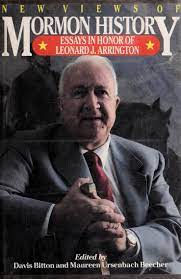Articles/Essays – Volume 21, No. 4
Honoring Arrington | Davis Bitton and Maureen Ursenbach Beecher, eds., New Views of Mormon History: Essays in Honor of Leonard J. Arrington
Leonard Arrington deserves to be honored. Nineteen of his professional associates, former employees, and friends have each contributed to this book a previously unpublished essay to thank a man who fostered their individual careers. Although Arrington’s contributions are highlighted in the introduction and the volume ends with a detailed bibliography of his work, the essays do not focus on him or on his all too-brief tenure as LDS Church historian from 1972-80. Each essay covers a topic of special interest to its author; only the authors’ appreciation for Arrington links the pieces together.
In some respects the volume is a historiographical statement. During Arrington’s years as Church historian, numerous scholars, young and old, inside and outside of the Church, were able to utilize Church archives and records in an unprecedented way. The result was a “New” Mormon history or at least a new view of the Mormon saga. Indeed, historians produced numerous volumes and articles published by scholarly presses and professional journals. The “in house” publications also benefited by the breadth of historical research and writing. Numerous religious historians like Jan Shipps, Lawrence Foster, and Mario dePilis considered Mormons writing objectively about their own historical experience new and exciting. Arrington and his colleagues shared a brief but fleeting moment of open scholarly glory.
But the reality of writing objective institutional history in a grand way became dangerous to the larger Church institution. Arrington’s plan for an officially sanctioned, eighteen-volume sesquicentennial history was scuttled in midstream, he was demoted, and his division was exiled to Brigham Young University in Provo — minus the historical documents.
Most of the contributors to this fest shrift participated with Arrington in that shining moment. They offer here articles that exemplify what Arrington sponsored and encouraged. Their work is in areas familiar to them; their narratives are neither threatening nor earthshaking. Like Arrington himself, the essays are appropriately calm, dispassionate, and straightforward. Each has considerable merit, but none will change many critical minds who champion a need for creative historical analysis rather than narrative description. However, their efforts deserve a close reading. I was most excited by two essays about women in the Church. Carol Corn wall Madsen’s “Schism in the Sisterhood: Mormon Women and Partisan Politics, 1890-1900” and Jill Mulvay Derr’s “Changing Relief Society Charity to Make Way for Welfare, 1930-1944” make significant contributions and fit well together in this collection since Arrington championed women’s issues and history. The political and social welfare contributions of Mormon women were and are tremendous. These essays certainly paint an alternative picture to the stereotype of homebound, downtrodden Mormon women.
In the final analysis, this collection of essays adds significantly to Mormon historiography. While the viewpoints are not necessarily new or intended to revise earlier preconceptions, the essays are good history, and they do service to the mentor and col league honored. They illustrate a continuing need for a complete and open analysis of the Mormon historical experience. Until the Church overcomes its fear of history, we must view the Arrington period as a mirage, so near, yet so far.
New Views of Mormon History: Essays in Honor of Leonard J. Arrington, edited by Davis Bitton and Maureen Ursenbach Beecher (Salt Lake City: University of Utah Press, 1987), 438 pp., $19.95.


 Back to full Issue
Back to full Issue

